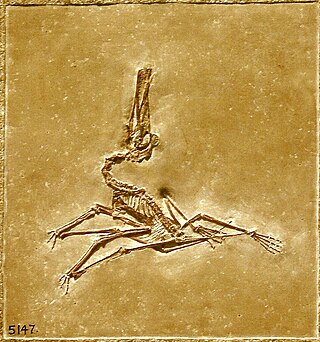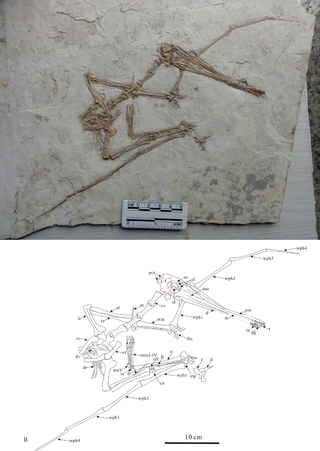
Eosipterus is an extinct genus of ctenochasmatid pterosaur from the Early Cretaceous period of Liaoning, China. Fossil remains of Eosipterus dated back to the Aptian stage of the Early Cretaceous, 125 million years ago.

Feilongus is an extinct genus of ctenochasmatid pterodactyloid pterosaur from the Barremian–Aptian-age Lower Cretaceous Yixian Formation of Beipiao, Liaoning, China.
Gegepterus is a genus of ctenochasmatid pterosaur from the Early Cretaceous period of what is now the Yixian Formation of Liaoning, China. Only one species is known, G. changi.
Liaoxipterus is a genus of pterodactyloid pterosaur from the Barremian-Aptian-age Lower Cretaceous Jiufotang Formation of Chaoyang, Liaoning, China. The type species is Liaoxipterus brachyognathus. The genus name is derived from the discovery locality Liaoxi and a Latinised Greek pteron, "wing". The specific name is derived from Greek brachys, "short" and gnathos, "jaw".

Nurhachius is a genus of istiodactylid pterodactyloid pterosaur from the Barremian to Aptian-age Lower Cretaceous Jiufotang Formation of Chaoyang, Liaoning, China. Its fossil remains date back about 120 million years ago.

Liaoningopterus, sometimes misspelled as "Liaoningopteryx", was a genus of anhanguerid pterodactyloid pterosaur from the Barremian-Aptian-age Lower Cretaceous Jiufotang Formation of Chaoyang, Liaoning, China.
Cathayopterus is an extinct genus of ctenochasmatid pterosaur from the Early Cretaceous-age Yixian Formation of Liaoning, China. The name means "China wing", using the word "Cathay" as an old alternative name for China. The type species is C. grabaui, described in 2006 by Wang Xiaolin and Zhou Zhongh. It is a member of the Ctenochasmatidae, a clade of mostly filter feeding pterosaurs from the Jurassic and early Cretaceous.

Ctenochasmatidae is a group of pterosaurs within the suborder Pterodactyloidea. They are characterized by their distinctive teeth, which are thought to have been used for filter-feeding. Ctenochasmatids lived from the Late Jurassic to the Early Cretaceous periods.

Ningchengopterus is a genus of pterodactyloid pterosaur from the Early Cretaceous period. Its fossil remains were found in the Yixian Formation of what is now China.

Zhenyuanopterus is a genus of boreopterid pterosaur which is known from Lower Cretaceous Yixian Formation of Liaoning, China. It contains one species, Zhenyuanopterus longirostris, which was first described and named by Lü Junchang.

Euctenochasmatia is an extinct group of pterodactyloid pterosaurs. It was named by David Unwin in 2003 as the group that contains the most recent common ancestor of Pterodactylus and Ctenochasma, and all their descendants.

Kunpengopterus is a genus of wukongopterid pterosaur from the middle-late Jurassic Tiaojishan Formation of northeastern China. The genus contains two species, the type species K. sinensis and K. antipollicatus.

Gladocephaloideus is a genus of ctenochasmatid ctenochasmatoid pterosaur from the Early Cretaceous period of what is now western Liaoning, China.

Jianchangnathus is an extinct genus of basal pterosaur from the Middle Jurassic Tiaojishan Formation of northeastern China.

Guidraco is an extinct genus of toothed pterodactyloid pterosaur known from the Early Cretaceous of Liaoning Province, northeast China. According to many recent studies, Guidraco is a member of the group Anhanguerinae, a subfamily belonging to the larger group Anhangueridae.

Moganopterus is an extinct genus of ctenochasmatid pterosaur from the Early Cretaceous of western Liaoning Province, China.

Chuanqilong is a monospecific genus of basal ankylosaurid dinosaur from the Liaoning Province, China that lived during the Early Cretaceous in what is now the Jiufotang Formation. The type and only species, Chuanqilong chaoyangensis, is known from a nearly complete skeleton with a skull of a juvenile individual. It was described in 2014 by Fenglu Han, Wenjie Zheng, Dongyu Hu, Xing Xu, and Paul M. Barrett. Chuanqilong shows many similarities with Liaoningosaurus and may represent a later ontogenetic stage of the taxon.

Ikrandraco is a genus of lonchodraconid pterodactyloid pterosaur known from Lower Cretaceous rocks in northeastern China and the Cambridge Greensand of the UK. It is notable for its unusual skull, which features a crest on the lower jaw.

Forfexopterus is a genus of ctenochasmatid pterosaur from the Early Cretaceous Jiufotang Formation in China. It contains a single species, F. jeholensis, named from a mostly complete skeleton by Shunxing Jiang and colleagues in 2016. A second specimen, consisting of a wing, was described in 2020. While the first specimen is larger, it shows signs of being less mature than the second specimen, indicating that the developmental trajectories of Forfexopterus were variable. Like other ctenochasmatids, Forfexopterus had a long, low skull filled with many slender teeth; unlike other members of the group, however, it did not have a spatula-shaped snout tip or crests, and its teeth were more curved. A single characteristic distinguishes Forfexopterus from all other members of the wider group Archaeopterodactyloidea: of the four phalanx bones in its wing finger, the first was shorter than the second but longer than the third.

Liaodactylus is a genus of filter-feeding ctenochasmatid pterosaur from the Jurassic of China. The genus contains one species, L. primus, described by Zhou et al. in 2017. As an adaptation to filter-feeding, Liaodactylus had approximately 150 long, comb-like teeth packed closely together. It is both the earliest known ctenochasmatid and the first filter-feeding pterosaur from the Jurassic Tiaojishan Formation. Later and more specialized ctenochasmatids differ from Liaodactylus in having longer snouts, smaller openings in the skull, and more teeth. Within the Ctenochasmatidae, Liaodactylus was most closely related to the European Ctenochasma.





























